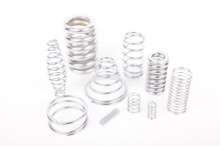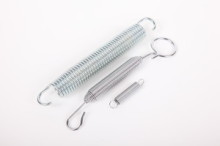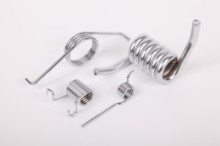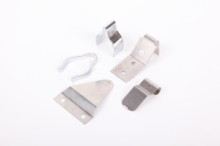Springs are found in most objects that we use in everyday life and often go unnoticed or unseen. Some examples of this could include; turning your light switch on and off, guiding your car over lumps and bumps in the road, and even putting your key into the front door to let yourself in. However, there are a numerous different types of springs that all have their own unique benefits for particular applications.
At Airedale Springs we know how important springs are and also how important choosing the best spring for your given application is, which is why we have been manufacturing, designing and supplying high-quality springs all around the world for just over 71 years. To compliment this, we decided to give you an informative and a somewhat scientific view of some of the different type of springs that we have been manufacturing for nearly three-quarters of a century.
Compression Springs
Compression springs are the most common type of spring that are available. Its orientation is very memorable, as it is an open-coil helix. The key aspect of this spring is that it offers a resistance when the spring is compressed axially (along the central axis of the spring). A great example of this is the spring in your retractable pen – when the pen is clicked, the spring is compressed and when the pen is clicked again, it releases its stored energy and returns to its original state.
These types of springs follow a specific law that was stated by British physicist Robert Hooke and is named after him – Hooke’s Law. It states that the force required to stretch or compress a spring by a certain distance is proportional to that distance. For different types of compression spring, this law holds true.

Extension Springs
Tension springs are very similar to compression springs, but the secret with these springs is that they are wound incredibly tight to oppose the extension. Because of this, they are said to be loaded in tension. This means that the spring stretches when a load is applied to it, such as that when using a chest expander in the gym.
One of the most common uses of extension springs is within trampolines. When you bounce on a trampoline, the springs are extended, but the secret of these springs is that the initial tension within the spring that releases the stored energy and causes the person on the trampoline to bounce in the air.
Torsion Springs
Torsions springs operate in a slightly different way to compression and extension springs. Unlike the load being applied axially, the load on a torsion spring is applied as a torque or twisting motion. This means that when this spring is twisted, it offers a resistance and causes the spring to return to its original position.
One common use of torsion springs is in clothes pegs. When you squeeze the peg, it opens up at the bottom and can be attached to a clothes line. In this squeezing process, the torsion spring is twisted and stores energy. Once you have put it on the clothes line and let go on the peg, the stored energy is released and the peg closes, as it should do.
Flat Springs
Flat springs are designed in a completely different way to the springs mentioned previously, but they still hold the same purpose. They are essentially small strips of metal that, when they are deflected by a load, store mechanical energy. They can be made from high carbon steels, nickel, beryllium-copper, and many other metals.
One of the most common uses of flat springs is known as a leaf spring. A leaf spring is a spring that is made of multiple flat springs of metal that are attached to one another. These springs are typically used in suspension systems of various vehicles to increase stability.
Springs can be used in so many applications and we, to be honest, do take them for granted. At Airedale Springs, we are industry leading spring manufacturers of all of these springs and a whole lot more. Why don’t you come and have a chat with us about them? Get in touch with us today on 01535 643456 and we will be more than happy to discuss any queries you may have.





